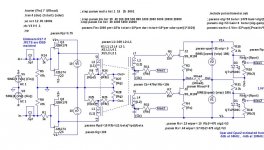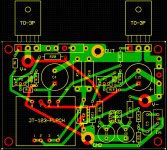Sure, the input stage could be something other than a complementary follower, but I think there are good reasons for that choice. The input stage needs to have a fairly low output impedance, because of the load imposed by the transformer, which is about 100R at 20Hz and 200R at 40Hz. This suggests a complementary follower stage rather than common drain. Sure, an opamp could be used and would provide the benefit of more voltage gain. But that would lead us off of the Pass Path.
in my opinion gain is not needed and the jfet follower the F6 has just passes the signal on in two directions, enough (like 0 dB - 700 mV RMS while the transformer and the input buffer can go up to +20 dB) to saturate the output stages far above the 2,4V max and deliver linear behavior.
So this is the Pure Pass Policy: keep it simple.
The input config (jfet follower or like Jensen shows in its appl notes with an opamp) is trivial.
Absolutely ZM; please do; it'll lower your blood pressure. Did you slip above and call Conceptual F6 a small power amp [bolded]; how big?🙂. That's the trick. Make ZM laugh and hell reward you with free info.OPA1632 is SUSY chip - diff in , diff out
it demands pretty lowish impedance feedback net, and it's having low output impedance
I was using it connected to sec of Beyerdynamic 1:10 mic xformer ; xformer ditto on outputs of two (diff connected ) PCM1704 , then feedback net defining reflected impedance back to chips , to have linear freq through audio band
driving xformer with small bridge power amp , to drive output of small power amp ........
........ may I laugh ..... just a little ?

Last edited:
Not meant to be OT, but I was thinking that beautiful SUSy chip with really nice distrtion numbers and low output Z would be kinda cool driving x-former symmetrical output stage. Somewhat redundant, but not altogether ridiculous. This is DIY.
well - if you need some gain , you can really put it instead of buffer and make nice integrated , with ball input
you can then connect two primaries in symmetrical manner , with overall FB connected from their CT to gnd (need to check that on paper , but seems logical in this moment )
)
but - do not forget that 1632 (and TSHA cousins ) like lowish impedance NFB net , resulting in lowish input impedance ; you need ball$ to drive it , too
you can then connect two primaries in symmetrical manner , with overall FB connected from their CT to gnd (need to check that on paper , but seems logical in this moment
 )
)but - do not forget that 1632 (and TSHA cousins ) like lowish impedance NFB net , resulting in lowish input impedance ; you need ball$ to drive it , too
Last edited:
A....... Did you slip above and call Conceptual F6 a small power amp [bolded]; how big?🙂.......
certainly
with usual FW PSU it can't be big - 25W/8 and 50W/4
Pa mentioned scaling ....... I think at least up to 3 pairs can be driven easily , with good results ; PSU voltage of OS can be at least double
so - 100W/8 is easily obtainable
Yup. got lots of bal...I mean preamps capable of that.
then you have double naked situation - you don't need OPA for gain ...... and using it instead of simple and effective buffer is .......... just imagine number of small critters packed in chain , due to necessary compromises in construction of every chip
well - if you need some gain , you can really put it instead of buffer and make nice integrated , with ball input
you can then connect two primaries in symmetrical manner , with overall FB connected from their CT to gnd (need to check that on paper , but seems logical in this moment)
but - do not forget that 1632 (and TSHA cousins ) like lowish impedance NFB net , resulting in lowish input impedance ; you need ball$ to drive it , too
And, if you float the power supplies you will get 2nd harmonic cancellation.
Our best source is Mr. Pass [earliest builder] who knows F5 and has been listening to F6. It is best to hear from him because he has the reference amps, loudspeakers and the experimental protocol to do a non-biased A/B comparison. Otherwise we may get conflicting reports!I'm anxious to know what early builders think about it and how it compares to the F5.
You do not need an opamp for balanced operation. Something this should also work and with floating power supplies will have 2nd harmonic cancellation. See also post #1055.
well - if you need some gain , you can really put it instead of buffer and make nice integrated , with ball input
you can then connect two primaries in symmetrical manner , with overall FB connected from their CT to gnd (need to check that on paper , but seems logical in this moment)
but - do not forget that 1632 (and TSHA cousins ) like lowish impedance NFB net , resulting in lowish input impedance ; you need ball$ to drive it , too
Attachments
lhquam: You've thought "outside the box" of Conceptual F6. Your attached schematic is solely your design; most probably infused with inspiration by Conceptual F6. You have been free to explore, experiment and thus create a prototype bridge amplifier.You do not need an opamp for balanced operation. Something this should also work and with floating power supplies will have 2nd harmonic cancellation. See also post #1055.
Yes, and no. One you float the power supplies, you might as well go all the way to the circlotron. The only difference is the position of the negative rail power supply relative to the lower output JFET (ie. swap the order). Once you have done this, you can avoid the transformer altogether using the "Amazing FET Circlotron" front end.
lhquam: You've thought "outside the box" of Conceptual F6. Your attached schematic is solely your design; most probably infused with inspiration by Conceptual F6. You have been free to explore, experiment and thus create a prototype bridge amplifier.
then you have double naked situation - you don't need OPA for gain ...... and using it instead of simple and effective buffer is .......... just imagine number of small critters packed in chain , due to necessary compromises in construction of every chip
Crossing out bad idea #42
- Home
- Amplifiers
- Pass Labs
- F6 Amplifier


